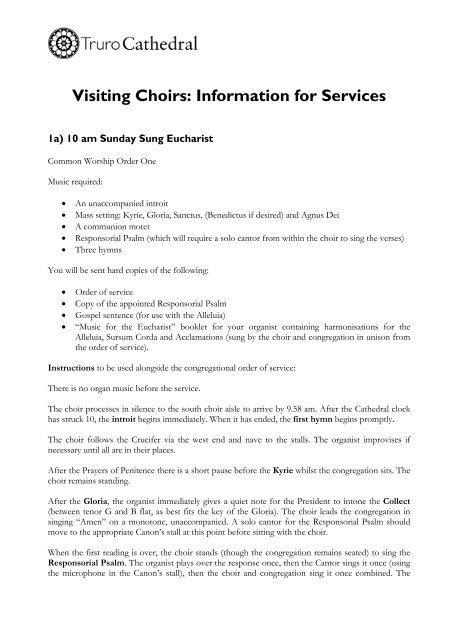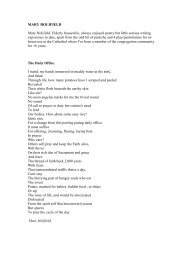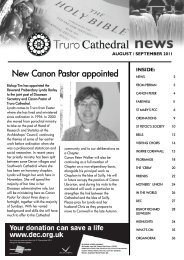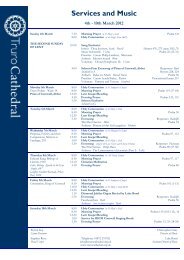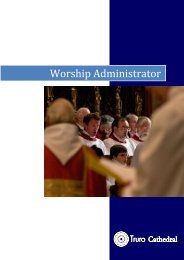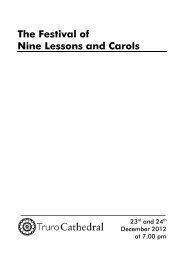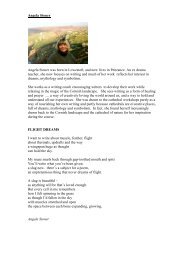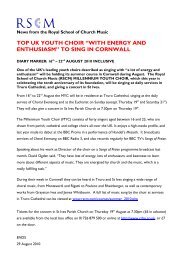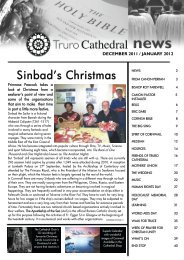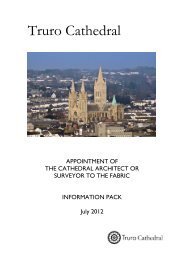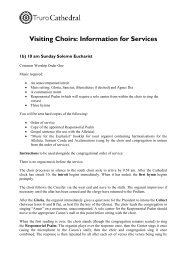1a 10am Sunday Sung Eucharist - Truro Cathedral
1a 10am Sunday Sung Eucharist - Truro Cathedral
1a 10am Sunday Sung Eucharist - Truro Cathedral
You also want an ePaper? Increase the reach of your titles
YUMPU automatically turns print PDFs into web optimized ePapers that Google loves.
Visiting Choirs: Information for Services<br />
<strong>1a</strong>) 10 am <strong>Sunday</strong> <strong>Sung</strong> <strong>Eucharist</strong><br />
Common Worship Order One<br />
Music required:<br />
• An unaccompanied introit<br />
• Mass setting: Kyrie, Gloria, Sanctus, (Benedictus if desired) and Agnus Dei<br />
• A communion motet<br />
• Responsorial Psalm (which will require a solo cantor from within the choir to sing the verses)<br />
• Three hymns<br />
You will be sent hard copies of the following:<br />
• Order of service<br />
• Copy of the appointed Responsorial Psalm<br />
• Gospel sentence (for use with the Alleluia)<br />
• “Music for the <strong>Eucharist</strong>” booklet for your organist containing harmonisations for the<br />
Alleluia, Sursum Corda and Acclamations (sung by the choir and congregation in unison from<br />
the order of service).<br />
Instructions to be used alongside the congregational order of service:<br />
There is no organ music before the service.<br />
The choir processes in silence to the south choir aisle to arrive by 9.58 am. After the <strong>Cathedral</strong> clock<br />
has struck 10, the introit begins immediately. When it has ended, the first hymn begins promptly.<br />
The choir follows the Crucifer via the west end and nave to the stalls. The organist improvises if<br />
necessary until all are in their places.<br />
After the Prayers of Penitence there is a short pause before the Kyrie whilst the congregation sits. The<br />
choir remains standing.<br />
After the Gloria, the organist immediately gives a quiet note for the President to intone the Collect<br />
(between tenor G and B flat, as best fits the key of the Gloria). The choir leads the congregation in<br />
singing “Amen” on a monotone, unaccompanied. A solo cantor for the Responsorial Psalm should<br />
move to the appropriate Canon’s stall at this point before sitting with the choir.<br />
When the first reading is over, the choir stands (though the congregation remains seated) to sing the<br />
Responsorial Psalm. The organist plays over the response once, then the Cantor sings it once (using<br />
the microphone in the Canon’s stall), then the choir and congregation sing it once combined. The
esponse is then repeated by all after each set of verses (the verses being sung by the solo cantor). The<br />
Gloria is not sung. After the Responsorial Psalm the cantor returns to the stalls and the choir sits.<br />
As soon as the second reading is over, the choir stands and sings the Alleluia. The choir sings from<br />
the printed order of service and the organist plays the harmonised version from the “Music for the<br />
<strong>Eucharist</strong>” booklet provided.<br />
The organist sounds an octave F and the choir sings the Alleluia once. It is then repeated with the<br />
congregation (with much louder organ accompaniment). The Gospel sentence follows (sung in<br />
harmony from the separate sheet provided) and then the Alleluia is sung one final time by the<br />
congregation and choir.<br />
Immediately after the sentence “Hear the Gospel of our Lord Jesus Christ according to N” the organ<br />
sounds a loud octave B flat. The choir and congregation then sing “Glory to you, O Christ” in unison<br />
on a B flat, moving to A on the word “Lord”. This is harmonised by the organist.<br />
After the Deacon says “This is the Gospel of the Lord” the organ sounds another loud octave B flat.<br />
The choir and congregation sing “Praise to you, O Christ” in unison on a B flat, moving to A on the<br />
word “Christ”. This is again harmonised by the organist.<br />
The organist then improvises until the procession returns to the podium and the preacher is in the<br />
pulpit. This usually takes about 30 seconds.<br />
We do not turn east for the Creed.<br />
Allow about 20 seconds for the peace to be exchanged before beginning the Offertory hymn. The<br />
organist should improvise afterwards until the collection has been brought to the altar and blessed.<br />
In Ordinary Time (for which the green order of service CW1 is used), the music list will advise which<br />
of the three printed <strong>Eucharist</strong>ic Prayers is used: A (on p 11), B (on p 15) or C (on p 18). The<br />
organist will find harmonisations for the Sursum Corda and Acclamation in the “Music for the<br />
<strong>Eucharist</strong>” booklet. The printed intonations should be played quietly to give the President / Deacon<br />
their note. The organ should then lead the congregation and choir clearly and quite loudly in the<br />
replies.<br />
The Benedictus is normally sung during the Communion but may be sung immediately after the<br />
Sanctus if both are short.<br />
A tenor G-B flat-G should be given promptly for the President to sing “Through him and with<br />
him…”. Sometimes the doxology (“Blessing and honour and glory and power…”) is sung straight<br />
after this, with organ accompaniment.<br />
During the Communion, the Benedictus (if not already sung), Agnus Dei and Communion motet<br />
are sung. The choir receives Communion after the congregation. The organist plays until the choir has<br />
received and is back in the stalls and the President is at the altar.<br />
At the end of the service, the voluntary begins immediately and the choir follows the Crucifer and<br />
clergy in procession (out the short way) via the South Choir Aisle and to the crypt. No prayer is said.<br />
The choir is warmly invited to join the congregation for coffee in the Chapter House after the service.


